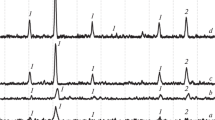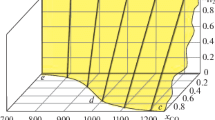Abstract
In this work the effect of additions of H2, H2O, CO2, SO2, and H2S on the catalytic decomposition of CO by iron has been investigated at 400, 600, and 800°C and atmospheric pressure. The catalyst was porous iron formed by the reduction of hematite ore granules with hydrogen. The relative importance of carbon deposition by the reactions 2CO → C + CO2 and H2 + CO → C + H2O was determined as a function of hydrogen concentration. It was found that even low concentrations of hydrogen greatly enhanced the rate of decomposition of CO, presumably by a catalytic action of adsorbed hydrogen on iron. The presence of water vapor had a dual effect. At low concentrations of hydrogen the rate of decomposition of CO increased with the addition of H2O, apparently by a catalytic effect. At high concentrations of hydrogen, however, carbon deposition was retarded because of the effect of the reverse reaction H2O + C → H2 + CO. In CO-CO2 mixtures the rate of carbon deposition decreased with increasing CO2 content, because of the effect of the reverse reaction CO2 + C → 2CO. The presence of traces of sulfur-bearing gaseous species, such as SO2 and H2S, retarded the decomposition of CO on iron and brought about the early cessation of carbon deposition. This strong effect may be due to the retardation of the decomposition of the intermediate product, cementite, and the formation of pyrrhotite on the surface of the iron catalyst.
Similar content being viewed by others
References
E. T. Turkdogan and J. V. Vinters:Met. Tram., 1974, vol. 4, pp. 11–19.
T. H. Byrom:J. Iron Steel Inst., 1915, vol. 92, pp. 106–12.
H. C. H. Carpenter and C. C. Smith:J. Iron Steel Inst., 1918, vol. 96, pp. 139–91.
O. Stelling:J. Metals, 1958, vol. 10, pp. 290–95.
H. H. Podgurski:Ann. N. Y. Acad. Sci., 1954, vol. 58, pp. 959–70.
W. Baukloh and G. Henke:Metall., 1940, vol. 19, pp. 463–70.
S. Klemantaski:J. Iron Steel Inst., 1952, vol. 171, pp. 176–182.
H. Schenck and W. Maachlanka:Arch. Eisenhüttenw., 1960, vol. 31, pp. 271–77.
K. H. Jack:Proc. Roy. Soc. (London), 1948, vol. A195, pp. 41–55.
L. S. Darken and E. T. Turkdogan: “Heterogeneous Kinetics at Elevated Temperatures,” pp. 25–95. Plenum Press, 1970.
W. A. Bone, H. L. Saunders, and J. J. Tress:J. Iron Steel Inst., 1938, vol. 137, pp. 85–101.
T. F. Berry, R. N. Ames, and R. B. Snow:J. Amer. Ceram. Soc., 1956, vol. 39, pp. 308–18.
P. L. Walker, J. F. Rakszaski, and G. R. Imperial:J. Phys. Chem., 1959, vol. 63, pp. 133–40, and 140–49.
M. R. Everett, D. V. Kinsey, and E. Romberg:Chemistry and Physics of Carbon, 1968, vol. 3, pp. 289–436.
Author information
Authors and Affiliations
Rights and permissions
About this article
Cite this article
Olsson, R.G., Turkdogan, E.T. Catalytic effect of iron on decomposition of carbon monoxide: II. Effect of additions of H2, H2O, CO2, SO2 and H2S. Metall Trans 5, 21–26 (1974). https://doi.org/10.1007/BF02642920
Received:
Published:
Issue Date:
DOI: https://doi.org/10.1007/BF02642920




